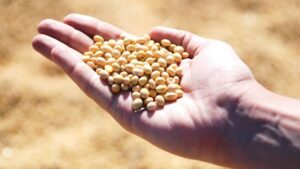
High protein canola meal is something I find myself speaking on more often these days. Canola is a hugely lucrative crop in Western Canada and prevalent in the north central and southeastern United States. The U.S. Department of Agriculture’s National Agricultural Statistics Service (NASS) estimates about 1.7 planted and harvested acres of canola in 2016 with average yield at 1,824 pounds per acre. This accounted for more than 3 billion pounds of canola production.
Canola is a great oil producer, and we’ve seen big yield increases over 10 years. It’s a hugely profitable crop for growers. The negative side of the plant has been the meal derived from it. Canola meal is a great fit for the dairy industry, and part of the reason why is actually one of its drawbacks — high fiber content. Ruminant animals like dairy cows love it, since they need the protein and their unique stomachs can process the high fiber levels.
But the high fiber content is a deal breaker for a large percentage of the livestock industry. Monogastric animals like pigs cannot handle the high fiber content of canola meal. One of the quality attributes of canola meal that makes it so attractive for one portion of the agriculture sector is exactly what makes it unattractive to another.
There’s another problem. If we look at the penetration rate of canola meal across dairy states in the U.S., most of them are approaching saturation levels. Canola growers simply can’t sell much more canola to these markets, resulting in more supply than there is demand, especially given the current quality attributes of canola meal.
Traditional industry thinking would spur us to simply find new markets for canola meal. Fish farms, maybe. If there’s one thing our industry is known for, it’s thinking outside the box.
Enter plant breeding and seed innovation. By changing the protein content of canola, we can make canola meal more useful for pigs and poultry. Canola with high protein and less fiber is very close to being widely available, developed through years of research and conventional plant breeding to maximize the protein content and digestibility of canola meal.
This process led to the creation of an advanced canola meal that offers protein content of about 44 percent, comparable to soybean meal and a significant improvement over conventional canola meal’s protein content of about 37 percent. The improved quality profile and nutritional benefits will significantly increase the inclusion rate potential in monogastric animal diets and opens up new opportunities for the seed industry and producers.
Furthermore, if canola meal can become as highly regarded as soybean meal, canola farmers could see higher demand for their crops. At the end of the day, innovations like this are a numbers game, and economics will determine whether high protein canola is widely adopted and can change the canola landscape, particularly in the United States.
More importantly, it offers a chance to engage in an important conversation about how we go about producing the massive amounts of protein we’re going to have to grow to feed the world over the next three decades. Outside-the-box thinking like this can help us find protein in places we may not think to look.













